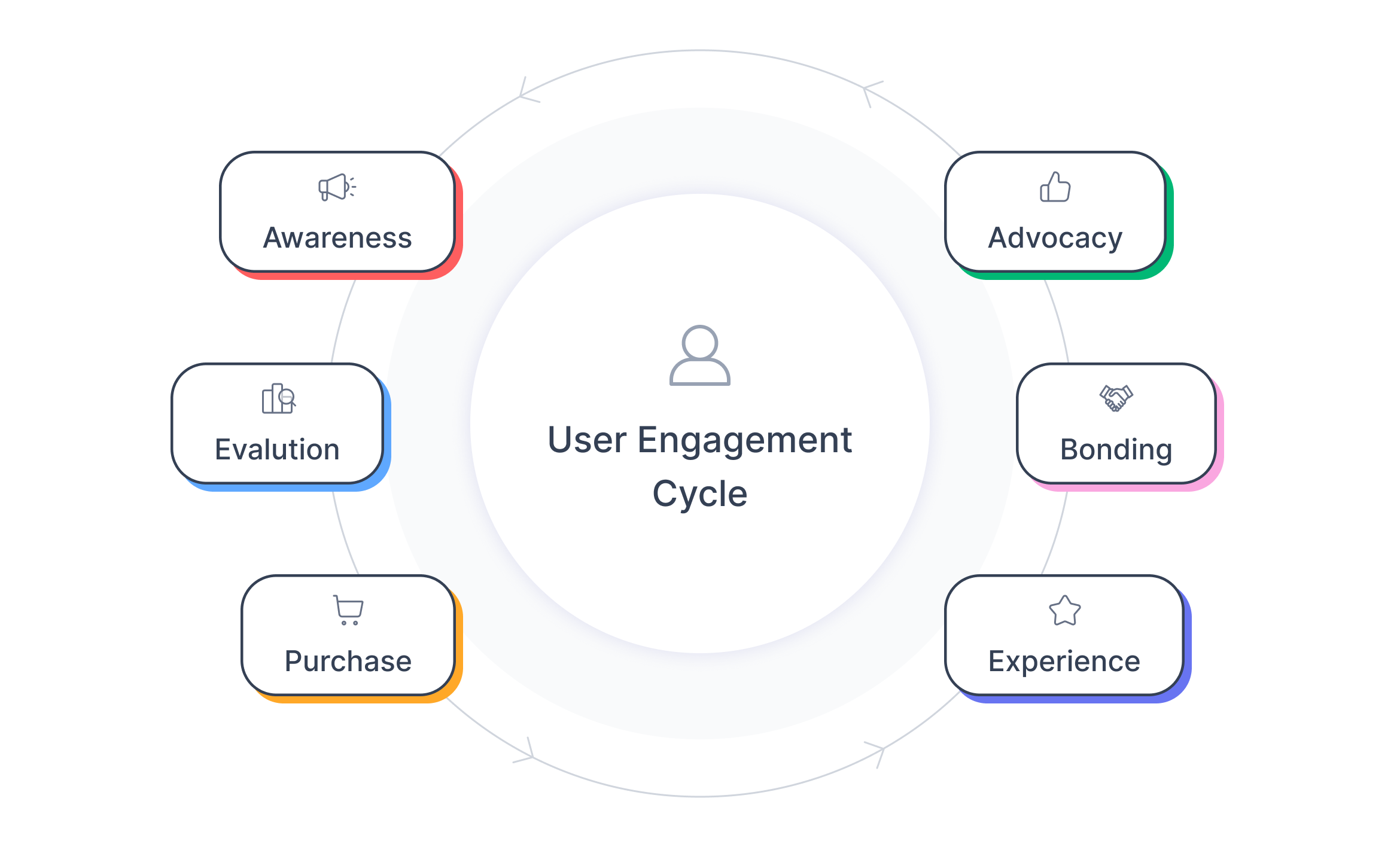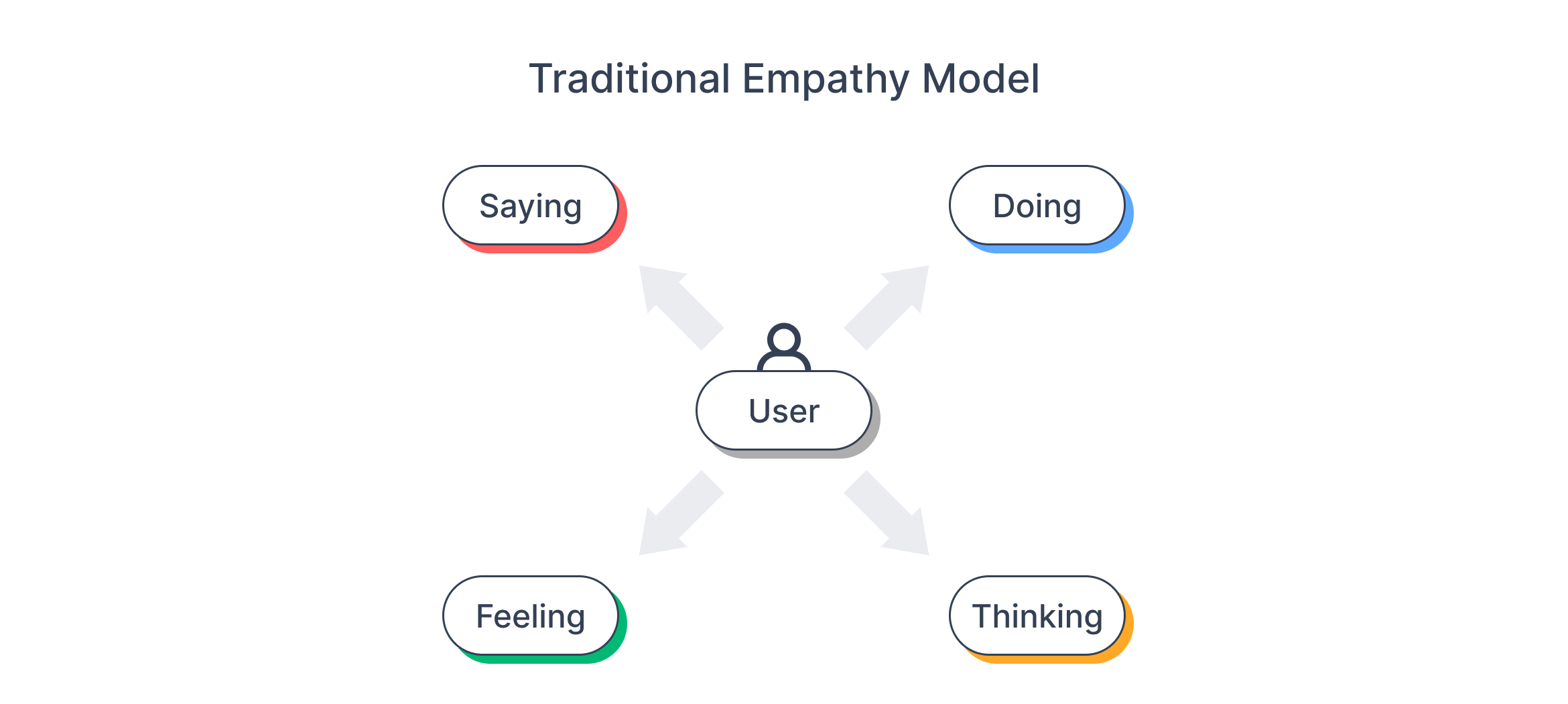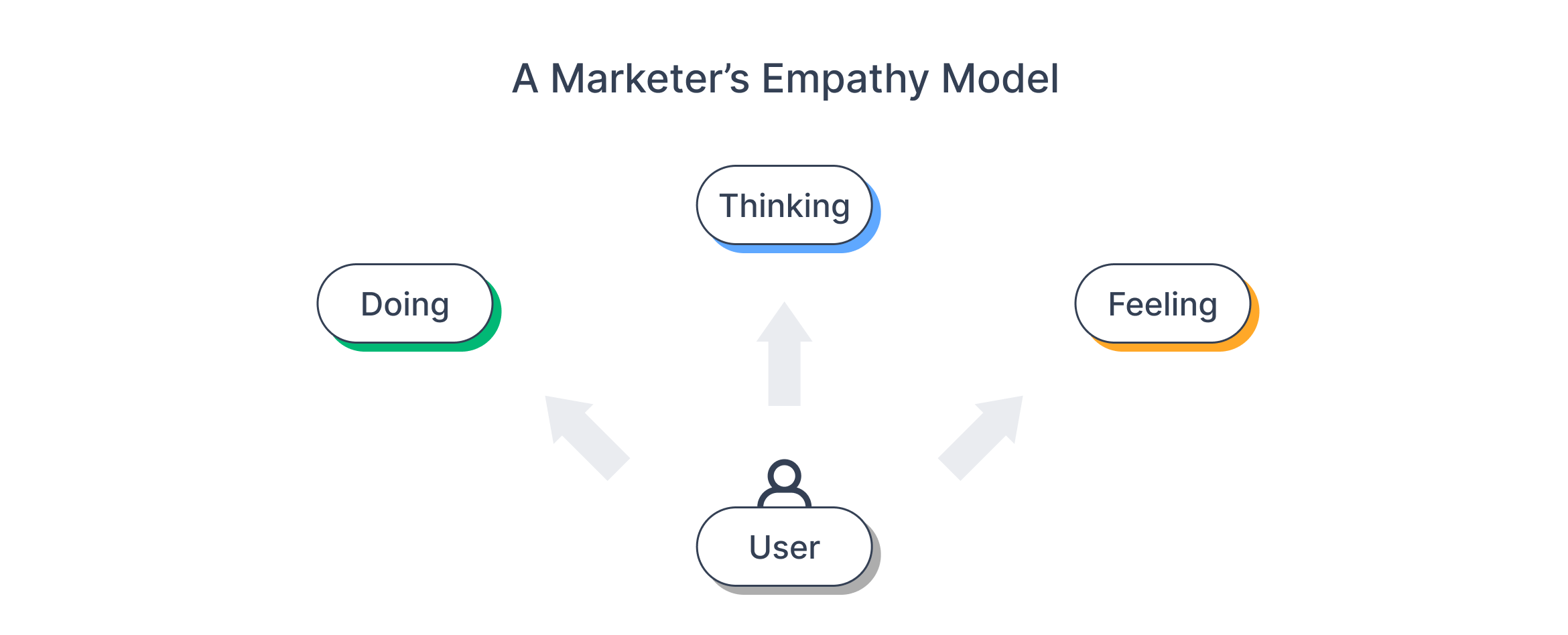Key Concepts
Preface: Different Businesses, Different Engagement Models, One Goal
Different businesses have varying definitions of what engagement means to them. Hence, explaining user engagement with a definite statement would be insufficient in expressing its importance.
What is User Engagement?
At WebEngage, we believe that user engagement is the degree and depth of brand focussed interactions a user chooses to perform. This extends beyond the transactions a user performs on your mobile app and website, to the brand focussed interactions they perform on social platforms or when meeting someone in person.
Simply put, if a user is thinking of you, then they're engaged.
But an effective engagement strategy is one that can convert this subconscious thought into actions that create value for your business.
Thus, for marketers like us, it all comes down to the revenue our user engagement efforts generate. The degree of engagement needs to be high enough to convert users into loyal customers who advocate your brand and transact frequently.
Engagement is an ongoing process throughout a user’s lifecycle and continues long after they have made a purchase. An ideal engagement strategy is one that builds trust, motivating users to continue their transactions over a long period of time and eventually become advocates of your brand, product or service.
Understanding the Stages of User Engagement
Here’s what an ideal engagement cycle looks like:

An ideal user engagement cycle helps you create brand advocates that help you acquire more users organically (Click to enlarge)
Let's break down each stage to help you understand how they tie back to the larger picture_(achieving sustainable growth through active engagement):_
Awareness
This is where it all begins. It's the stage where users become aware of your existence and start forming an impression of your brand, product or service. Generally, awareness is a result of repeated interactions with ads, digital content and word-of-mouth recommendation from friends, family or influencers.
The key here is to:
- Identify the right audience
- Create interest with messaging that conveys your value proposition
- Appeal to their emotions with relatable messaging and visuals
End Goal: Convert users' awareness into proactive interest and engagement.
Evaluation
Every customer goes through this phase, whether it's months of research or a quick factual check to reinforce their purchase decision. For example, a user making a significant purchase, like investing a month-long cruise vacation or purchasing a car will often spend more time evaluating the brand than users looking to buy a hairdryer.
Conversion of Awareness into Evaluation could mean any of the following actions, depending on your business:
- Signing up for email newsletters
- Taking a free trial of your online services
- Opting in for Web Push notifications
- Engaging with you on social media platforms
- Signing up for a demo/ Requesting a meeting with your representatives
The key here is to:
- Provide the users with consistent information through their preferred channels of engagement
- Supplement product/service information with social proof
- Nudge them periodically with engaging content to keep their interest alive
End Goal: Create a sense of trust and reliability that pushes users to make a purchase.
Purchase
The most crucial stage of the engagement cycle, providing your users with all the support they need to go through with the purchase is critical at this point.
The key here is to:
- Make the purchase process as seamless and short as possible
- Offer multiple ways to complete the purchase
- Provide customer support (live chat, customer care phone number, FAQs, etc.) to assist the purchase
- Personalize up-sells and cross-sells in a manner that adds value to the user's existing purchase
End Goal: Live up to the expectations you set in the first two stages and establish trust.
Experience
Attracting a new customer is six to seven times more expensive than retaining an existing one! This is why most consumer businesses have started investing proactively in creating contextually personalized experiences.
The key here is to:
- Understand the needs, preferences, and expectations of your customers
- Segment users into small, differentiated groups and devise a long-term engagement strategy for each
End Goal: Show your customers how much you value them by delivering tailored experiences, stitched seamlessly across channels and platforms.
Bonding
You can think of this stage as an extension or an end-result of delivering exceptional customer experiences. It's the post-purchase phase where you cement your relationship with a customer and the first step of nurturing brand advocates.
The key here is to:
- Continue delivering valuable experiences each time a customer interacts with your brand
- Motivate users to share their experience and invite acquaintances to try your products/services
End goal: Cultivating a long-lasting relationship with your customers that foster brand loyalty and growth (repeat purchases).
Advocacy
One of the most challenging aspects of user engagement is creating enough value over a long period that helps convert existing customers into brand advocates. It's a slow, tedious process that requires your marketing, customer support, and product teams to proactively work together with a customer-centric approach.
Brand advocacy could mean any of the following actions, depending on your business:
- Posting positive reviews for your brand on other platforms
- Submitting positive reviews for your products/services on your app/website
- Recommending your product/service to other people via a referral scheme or word-of-mouth
- Encouraging friends and family to adopt your products/services by demonstrating how it has improved their lives
End goal: Nurturing brand advocates who help you create awareness and acquire new users in the process (thus, completing the engagement cycle).
Creating an Engagement Strategy
At WebEngage, we work closely with hundreds of consumer businesses daily, helping them streamline their customer engagement efforts. Over the years, we have learned that the most efficient growth strategy is one that is guided by a customer first mindset.
However, most businesses overlook the impact loyal customers can have on their revenues and brand image in the long-term. Instead, they choose to focus on short-term monetary gains afforded by an acquisition-heavy strategy.
Thus, irrespective of the industry you're in, we have devised a simple 3-step model to help you create a winning engagement strategy:
Step 1: Empathize with Your Users
The first step is knowing who your users are and what they REALLY want. For marketers like us, practicing user empathy requires a shift from marketing-centric thinking to more a customer-centric thought process.
Presenting, the User Empathy Model. - Your key to understanding a user's emotional motivators, identifying gaps at each step of their journey and bridging them with effective engagement.
Traditionally, an empathy model is split into four sections, helping you capture crucial emotional and behavioral points of a user's experience:

1. Saying: Captures what the users share about their experience.
This could range from verbal feedback received by your customer support executive, feedback collected through an NPS survey, social media post, email, chatbot and so on.
2. Doing: Captures the actions a user performs to achieve a specific goal.
This could range from actual video grabs from a heatmapping software to mining behavioral data for insights.
3. Thinking: Captures what the user could be thinking of, throughout the experience.
When empathizing, analyze the data collected under Saying, Doing, and ask yourself:
- What matters to the user?
- What are their motivations?
- What are their concerns?
4. Feeling: Captures the user’s emotional state throughout the experience.
When empathizing, analyze the data collected under Saying, Doing, and ask yourself:
- What worries the user?
- What excites the user?
- What is the user hiding or reluctant to convey?
- How does the user feel about receiving communication from you?
A Marketer's Empathy Model
While surveys and reviews are great for collecting inputs from some users, it's not always possible to gather what a user says when they:
- See your ads
- Casually browse through your website
- Read your blog posts or watch a video
- Shortlist products but never end up purchasing them
- Uninstall your app
- Follow your brand on social media platforms, and so on.
Thus, a digital marketer's empathy model relies heavily on behavioral data (Doing) and looks something like this:

We have mapped each stage of user engagement to the empathy model to help you create an engagement strategy best suited to your business. You can create a map for each segment for better results:
Stages of Engagement | Doing | Thinking | Feeling |
|---|---|---|---|
Awareness | ▶️ Browsing through the internet. 🔎 ▶️ Reading blog posts. 📖 ▶️ Watching videos. 👀 ▶️ Listening to podcasts. 👂 | ▶️ This looks like something I can use! 😻 ▶️ I wonder what others think of this product. 🤔 | ▶️ Excited to discover a new product. 😁 ▶️ Not sure if it’s the best option out there. 🤷♀️ ▶️ Interested in knowing more about the product. 🤔 |
Evaluation | ▶️ Reading reviews by existing customers. 📖 ▶️ Watching product videos. 👀 | ▶️ Who offers the best price? 🤑 ▶️ Who’s the most trusted vendor in the market? 🛍️ | ▶️ Need some reassurance to go ahead with my decision. ☔️ |
Purchase | ▶️ Searching for a product. 🔎 ▶️ Scanning through product details. 🧐 ▶️ Adding product to cart. 🛒 ▶️ Purchasing the product. 💰 | ▶️ Where can I call them if I have a query or a problem with the product? ☎️ ▶️ What’s their return policy? 🔙 ▶️ Which shipping option should I choose? 🤔 ▶️ Do I need to pay extra for shipping? 💸 ▶️ Do I really need to sign up or can I just purchase as a guest? 🤔 | ▶️ Unsure about divulging too many personal details. ㊙️ ▶️ Sceptical of receiving promotional emails/ calls/ messages from other vendors. 📞 |
Experience | ▶️ Looking for a way to track the order. 🚚 ▶️ Tracking if it has been shipped. 🎁 ▶️ Checking for delivery updates. 📨 | ▶️ Can I track the order somewhere? 🧐 ▶️ Will my order ship on time? ⏳ ▶️ How can I return it if I don’t like it? 🔁 | ▶️ Nervous if the product will actually arrive. 🚚 ▶️ I hope I don’t miss the delivery. 🚩 ▶️ I hope it’s exactly what the description & reviews say. 🎁 |
Bonding | ▶️ Interacting with emails, push notifications to discover new products on your platform. 📩 ▶️ Exploring new products/ services/ features of your platform. 🔔 ▶️ Enrolling for a loyalty program. ❤️ | ▶️ Do they have any other products or services that I can purchase? 🛋️ 👗👢 ▶️ Let me check if they have | ▶️ Interested in doing more business with you. 🧑🤝🧑 ▶️ Thrilled to have a good experience again & again. 💃 ▶️ Looking forward to premium offers & discounts. 💯 |
Advocacy | ▶️ Writing a positive review on your app/website. 💬 ▶️ Recommending your app/website/product to their colleagues & friends. 🧑🤝🧑 ▶️ Interacting with you through social media platforms. 🤳 | ▶️ I really like this brand, they understand my needs so well! 🥰 ▶️ I want more people to experience this. 🗣️ ▶️ It’s a nice offer/product, my friends could benefit from it! 👯 | ▶️ Happy & content. 😇 ▶️ Confident in the brand’s ability to deliver great experiences to the people I have recommended it to. ✨ |
Now that you have a broad idea of what your users are Doing, Thinking and Feeling at different stages of their lifecycle, let's show you how you can engage them with tailored communication.
Step 2: Create Contextually Personalized Messages
At WebEngage, we are obsessed with helping businesses, like yours, fuel sustainable growth via data-driven engagement across your users' lifecycle. This is why user data (User Attributes) and behavioral data (Events and Event Attributes) lay the foundation for all your user engagement activities.
By helping you leverage crucial data points related to each user in your messages, our marketing automation suite enables you to program one-on-one experiences with great ease. This is made possible by the various channels of engagement listed in your dashboard and the journey designer - a tool that helps you execute contextual cross-channel engagement across your user's lifecycle.
Let's get you started!
Step 3: Test, Analyze and Optimize!
Customer engagement doesn't end with just sending campaigns. It's followed by a gruesome routine of analyzing, testing and optimizing your messages to determine the exact mix for creating a hit campaign.
Here's how your dashboard enables you to test and analyze campaigns, channels, and user behavior across your users' lifecycle:
-
The campaign creation experience of your dashboard facilitates easy multi-variate testing. All you need to do is - create multiple variations of your message and hit send! We’ll automatically identify the winning variation and send it to your target audience.
-
You can extensively analyze the performance of all your campaigns through the Campaign Overview section ofPush, In-app, SMS, Web Push, Email.
-
Further, you can also compare the performance of all your campaign through the Channel Overview ofPush, In-app, SMS, Web Push, Email. And lastly, you can gain top-level insights into the impact of all your user engagement efforts through Engagement Overview and a Journey's Overview section.
- These sections have been specially designed to facilitate in-depth analysis of your user engagement efforts against several performance indicators like Deliveries, Clicks, Conversions, Revenue, Uninstalls and so on.
-
Additionally, you can gain deep insights into how your users are engaging with your platforms and channels across their lifecycle through several tools including Events, Funnels, Cohorts and Uninstall analytics.
-
And, you can always retarget users on Facebook & Instagram by Exporting your Segments. :)
Do give these features a swing and let us know what you think!
Updated 26 days ago
Let's get you acquainted with all the concepts related to engagement, starting with the basics: